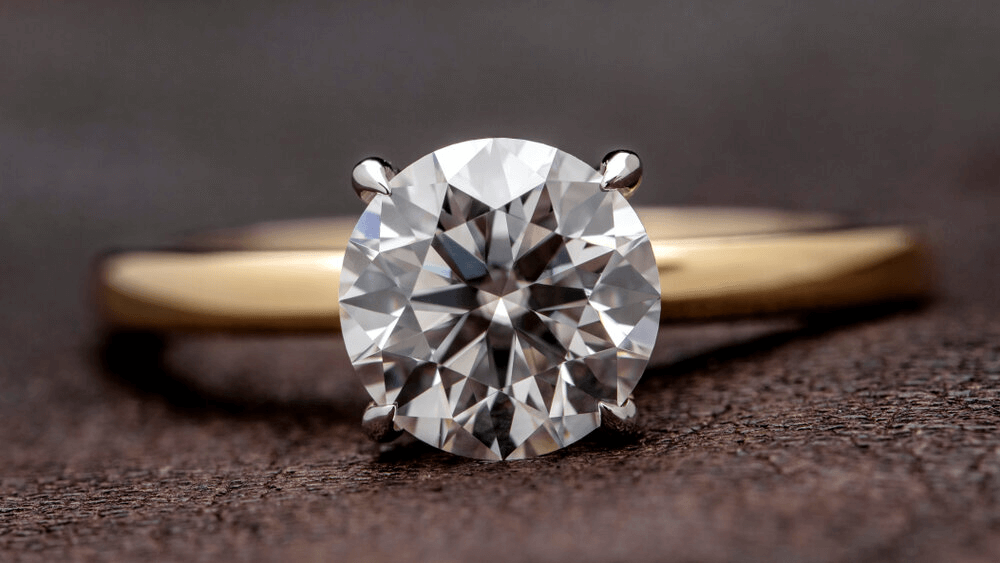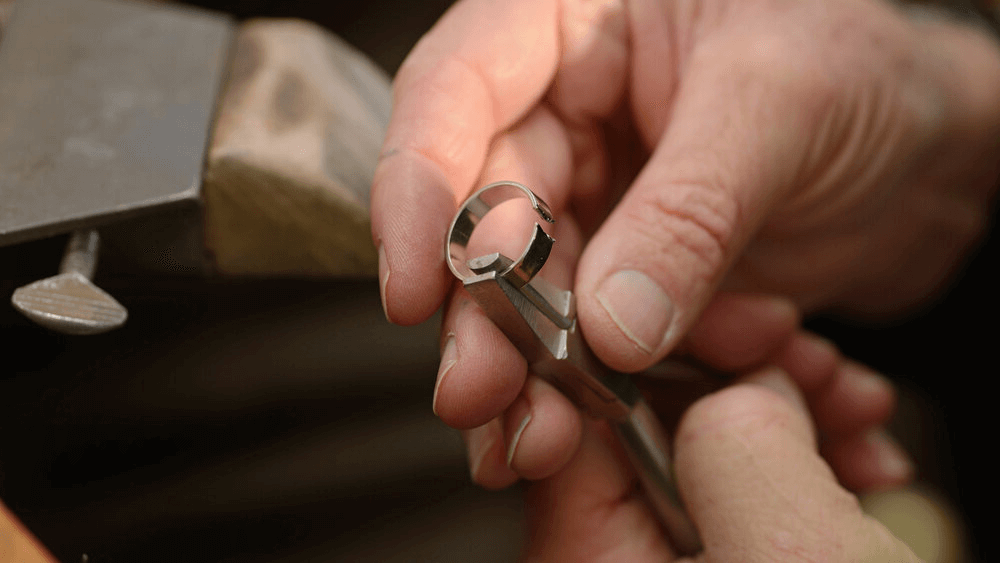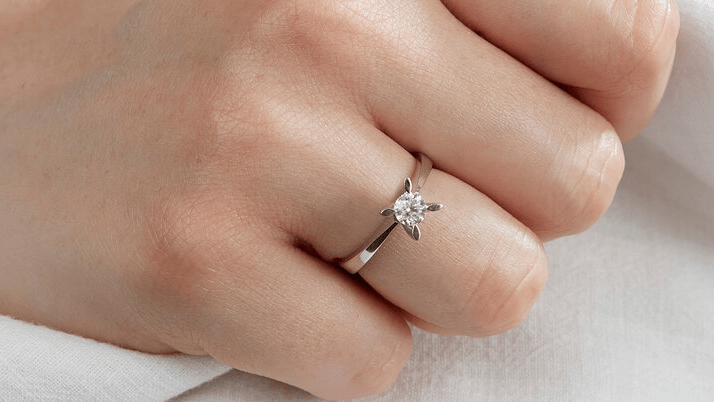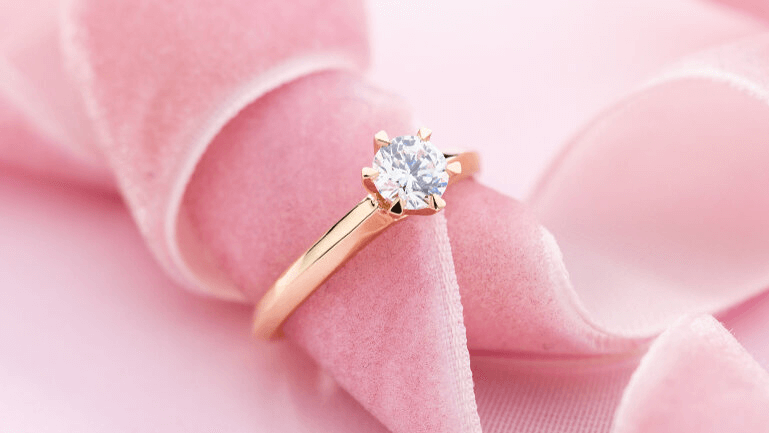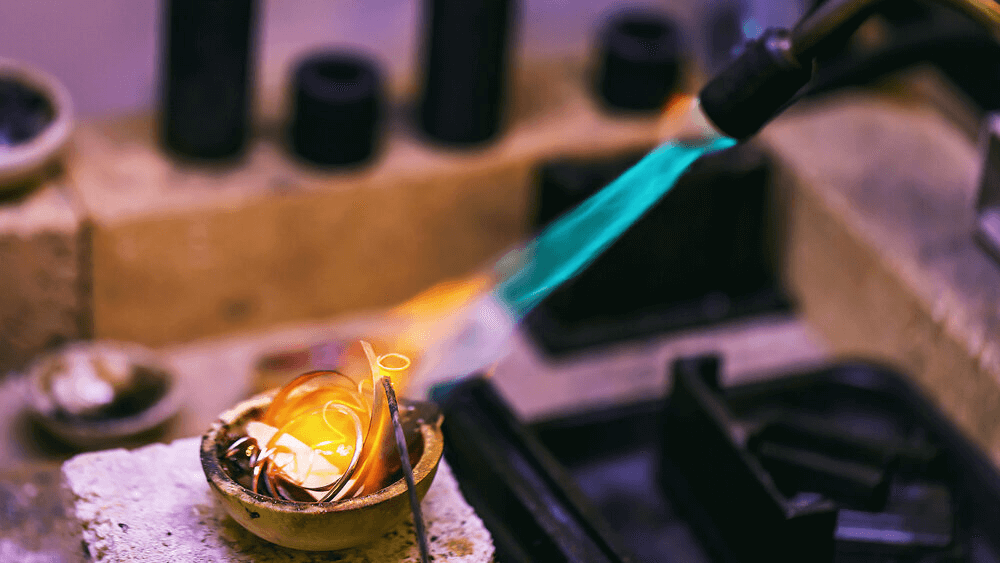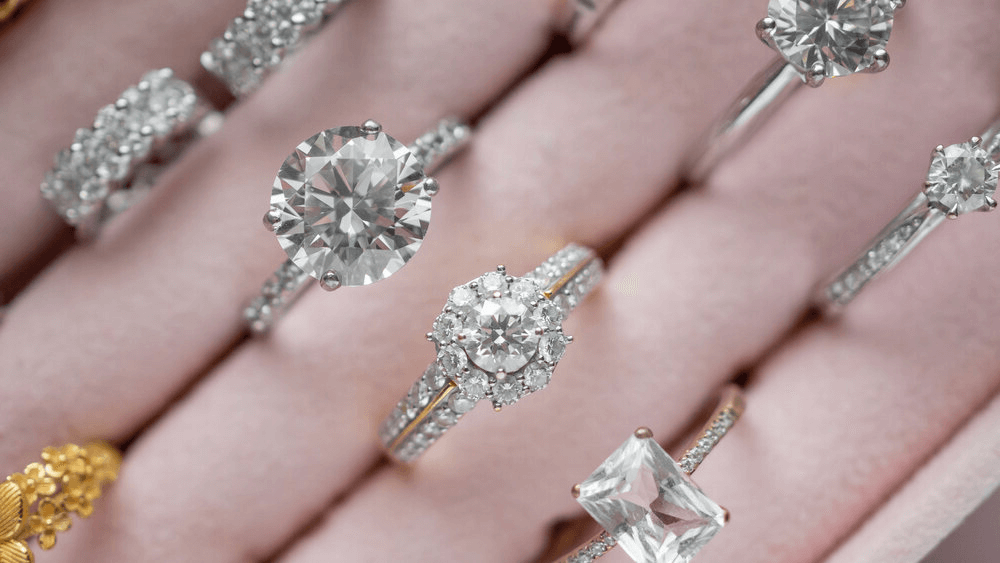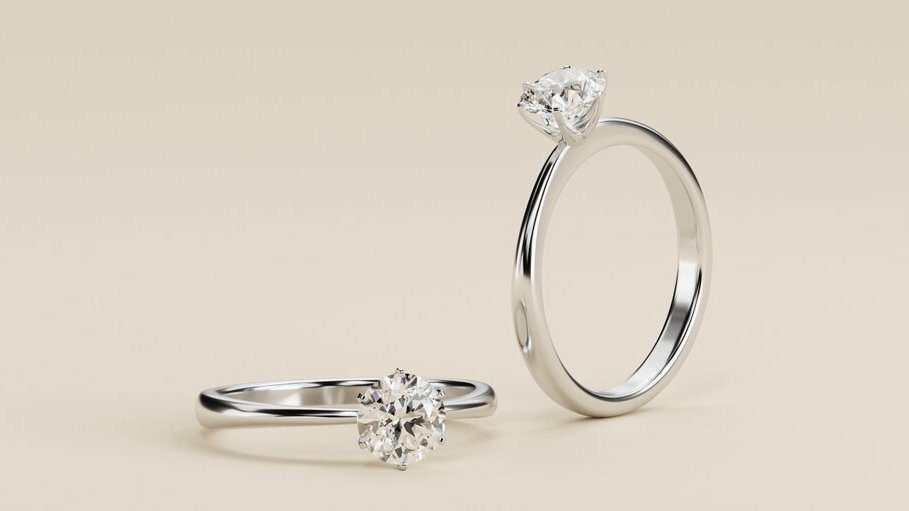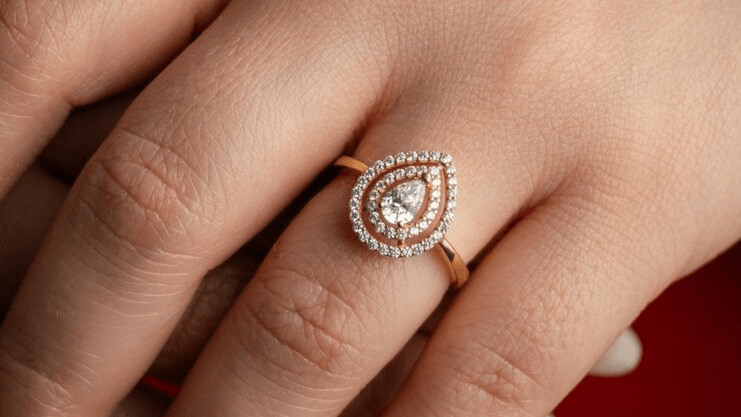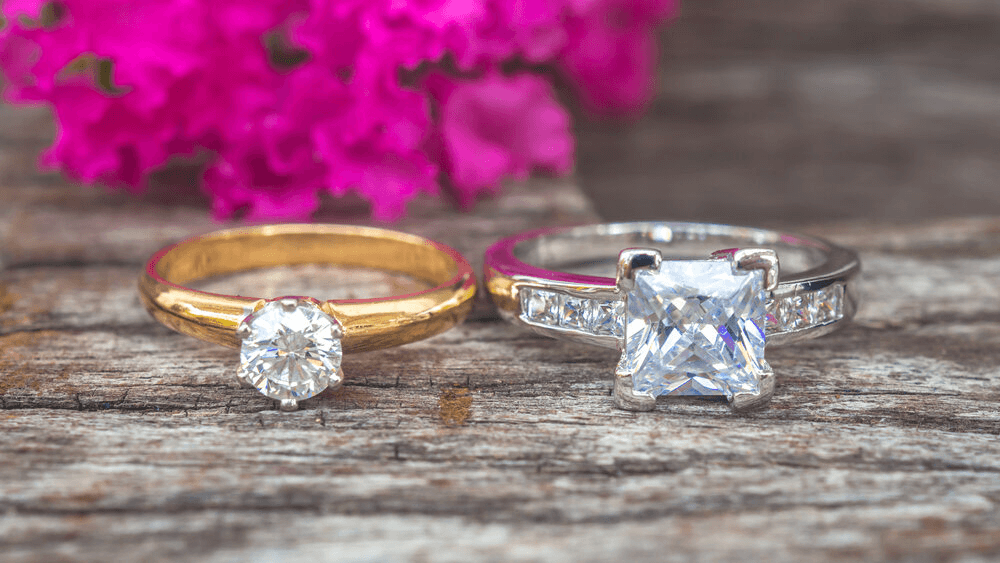Why Everyone Is Talking About Black Gold Rings

By Gary A.

Edited by Olivia H.
Published Aug 13, 2024
Edited on Mar 31, 2025
Explore black gold engagement rings, their creation, value, and how they compare to traditional gold in this comprehensive guide.

Navigate this guide:
- 7 Quick Tips for Choosing a Black Gold Engagement Ring
- Introduction to the Enigma of Black Gold
- The Historical Context of Black Gold
- The Art of Crafting Black Gold
- Evaluating the Worth of Black Gold
- Black Gold Versus Traditional Metals: A Comparative Insight
- Styling With Black Gold: A Guide for the Modern Suitor
- Our Expert Take
- 9 Frequently Asked Questions about Black Gold Rings
Before we dive deeper into the specifics of black gold engagement rings, here are some practical tips to help guide your decision-making process.
7 Quick Tips for Choosing a Black Gold Engagement Ring
- Tip 1: Understand the Creation Process:
- Black gold isn’t naturally occurring. It’s typically yellow gold that has been treated or alloyed with other metals to achieve its dark hue. Familiarize yourself with the methods used, such as electroplating, laser treatments, or alloying with cobalt. Each method has its pros and cons concerning durability and longevity.
- Tip 2: Check the Underlying Gold’s Purity:
- The value of black gold largely depends on the karat of the underlying yellow gold. Always ask about the gold’s karat (14k, 18k, etc.) to ensure you’re getting the quality you’re paying for. Remember, higher karat gold is purer but also softer, which might affect the ring’s durability.
- Tip 3: Replating and Maintenance:
- If the black gold ring is created using electroplating, be aware that the plating can wear off over time, revealing the yellow gold beneath. This means you might need to have the ring replated periodically. Inquire about the maintenance requirements and potential costs associated with this.
- Tip 4: Authenticity and Certification:
- Due to the unique nature of black gold, it’s crucial to purchase from a reputable jeweler. Ask for certifications or proof of the ring’s authenticity. Some jewelers use X-ray fluorescence technology to verify the gold content beneath the black layer.
- Tip 5: Gemstone Compatibility:
- Black gold offers a dramatic backdrop, but not all gemstones pair well with it. Opt for stones that contrast well against the dark setting, like clear diamonds or vibrant colored gems. Ensure the gem’s setting is secure and complements the ring’s overall design.
- Tip 6: Resizing and Adjustments:
- Black gold rings, depending on the creation method, might be challenging to resize without affecting the color or integrity of the metal. Before purchasing, ask about the possibility and costs of future adjustments.
- Tip 7: Price and Value:
- Black gold engagement rings can vary significantly in price based on the creation method, the purity of the underlying gold, and any gemstones included. Always compare prices, keeping in mind that the cheapest option might not always be the best in terms of quality and longevity.
Now that you’ve got these practical tips, use Jeweler AI below to find the perfect engagement ring that suits your style and budget:
Introduction to the Enigma of Black Gold
When we think of gold, we think of… well… gold. The metal is so synonymous with that unique shade of warm, bright yellow that, for most of us, it’s hard to rewire our brains to picture anything else. This, even in spite of the popularity of white gold and rose gold. While both are very good choices for an engagement ring, most of us still think of that yellow first.
So, what do you think of when we say the phrase black gold? Hard to imagine? You wouldn’t be the only one…
What Is Black Gold?
For starters, it’s something of a misnomer. In other words, while black gold Is an option from some jewellers, It’s not exactly comparable to, say, white or rose gold.
What do we mean by this? Well, white or rose gold are made by alloying pure gold with a specific combination of other metals that alter the hue of the gold. In higher karat golds, where less alloying metal is used, more of that original yellow tint shows through. True, In the case of white gold, rhodium plating is often used to enhance that bright white look, but, even so, the metal content is alloyed enough to achieve a very pale, close-to-white hue.
Black gold is different. This is gold that has been electroplated with black rhodium, which is what gives it that distinctive dark color. The treatment is relatively niche and not as widely known or used as other gold variants like white or rose, largely because the end result doesn’t resemble the type of metal we would typically associate with the high status of gold.
However, these days, more and more people are looking to put their own personal stamp on their ring collection. For some, the edginess of black gold is the perfect dress.
The Historical Context of Black Gold
The concept of making gold black is relatively modern, And most of the examples we see come from the late 20th century – or, of course, the 21st. Since the more traditional, more classically feminine designs tend to prevail in the world of bridal jewelry, black gold has never really made a big splash in mainstream circles.
The trend gained popularity in men’s jewelry and high fashion accessories since it offers an unconventional aesthetic and a bold spin on tradition. For obvious reasons, it’s also the perfect choice for a gothic engagement ring.
The Art of Crafting Black Gold
To get gold black, the maker needs to conduct surface treatments rather than altering the gold itself. So, by the time gold is turned black, it will already have been alloyed to a certain karat type like 18K or 14K.
Since you’re covering the gold, it doesn’t matter what carrot type you pick, although some people will still be keen to get a higher karat type as it represents a higher-status investment.
Modern Techniques for Creating Black Gold
There are three main methods for making gold appear black:
- Black Rhodium Plating
although the results are very different, this is somewhat similar to the rhodium plating applied to white gold. Rhodium is a rare metal and, for white gold, is applied in a very thin, reflective layer that lends it that silvery-white appearance; for black gold, the rhodium itself needs to be combined with certain alloys or chemicals to give it that dark appearance.
As with white gold, black rhodium plating will need to be redone every once in a while in order to maintain the same even appearance across the band’s surface. - Laser Treatment
A laser can be used to create nanostructures on the surface of the gold. When done right, these nanostructures absorb light and cause the gold to appear black to the naked eye. Under a microscope, these nanostructures are much more noticeable.
- Alloys
We said before that black gold is not created using alloys. Technically, this is untrue, since it is possible – it’s just far, far less common and much more expensive, so you’re unlikely to come across any alloyed black gold.
Alloys like cobalt and chromium can give it a much darker appearance, but the results are very inconsistent. With a high cost and a low chance of success, alloying gold to make it black is rarely done.
The Durability and Care of Black Gold Jewelry
As we mentioned above, black gold that features a rhodium plating – which is by far the most common – requires some upkeep. Rhodium doesn’t last forever, particularly if the ring is being worn on a daily basis. The finger is a very high-wear area for jewelry to be worn. While earrings will last much, much longer, rings tend to wear off faster.
In the case of white gold, it’s easy enough to return the ring to a jeweller and ask them to apply a fresh layer of rhodium plating. In theory, the same can be said for black gold, but due to its rarity, there are likely many jewellers who do not offer a re-plating service for black gold. It’s not impossible, but it’s also not particularly common.
Evaluating the Worth of Black Gold
Gold has a set market price, but alloying and treatments will influence exactly how much you pay…
The True Value Behind Black Gold
The value of black gold primarily depends on the underlying gold’s purity (e.g., 18K) and the quality of the blackening process, such as rhodium plating. Since the blackening does not alter the intrinsic value of the gold, you won’t notice any major price difference between black gold and regular gold of the same karat type.
However, black gold can go for more money due to its unique aesthetic, rarity, and the additional craftsmanship involved in creating it. It’s not the kind of thing you see at many jewelry stores, so be prepared to pay a premium if you do find it.
Authenticity and Certification: Ensuring Quality
Focus on reputable jewellers who provide certification for the gold’s purity, and look for that distinctive hallmark within the band. It can be harder to identify whether black gold is the real deal or not, since it doesn’t have any of the distinctive visual traits of yellow gold.
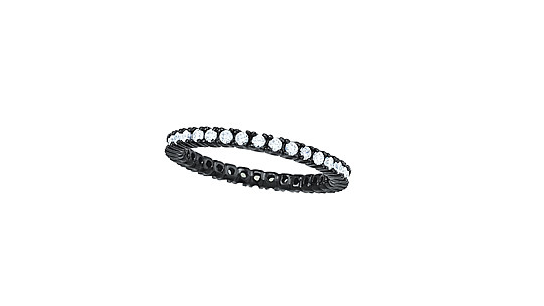
Black Gold Versus Traditional Metals: A Comparative Insight
Let’s face it, most of us don’t think of black gold when we think of our dream engagement ring or wedding band. Chances are, until now, you weren’t even sure if it was real or not. Black gold is incredibly uncommon, even today, with more and more people looking for unique alternatives to traditional metals.
Still, there are some advantages…
Advantages of Black Gold Over Other Metals
- It’s unique
Black offers a bold, modern look that stands out compared to traditional gold or platinum. You won’t see many engagement rings like yours if you opt for black gold, and some of us want a unique engagement ring more than anything… - It’s pretty durable
The rhodium plating enhances its resistance to scratches and corrosion. - It’s versatile
It pairs well with a variety of gemstones, highlighting their colors and brilliance. - It’s symbolic (in its own way)
While yellow gold has been the symbol of romance and devotion for thousands of years, black often symbolizes strength, elegance, and sophistication – all great qualities in an engagement!
Styling With Black Gold: A Guide for the Modern Suitor
If you’re worried about that dark hue sapping too much light from your ring, compensate with a few extra diamonds. A pavé setting can be great for reintroducing light, getting that joyful sparkle back, and avoiding everything feeling a little too ‘Addams Family’. Similarly, a halo or channel setting can be a great way to balance out the gothic vibes.
Alternatively, embrace the Gothicism! A peekaboo gemstone in a dramatic shade of red or purple, a salt and pepper diamond and plenty of ornate filigree will achieve a look perfect for the next vampire ball.
Gemstone Pairings and Design Considerations
As always, diamond is the obvious choice here. Not only is it the hardest gemstone, making it the right choice for an engagement ring that you want to keep for decades, but it also is the most effective gemstone for light performance. If you want plenty of sparkle in the form of fire and brilliance, then you’ll want to go for diamond. And, if you want to pair your black gold with a dramatically colored gemstone, fancy color diamonds are always there to breathe new, creative life into your ring design.
Fancy something a little different? Black goes with everything. If it didn’t, the little black dress wouldn’t have become the wardrobe staple that it is today. Take a look at our guide to diamond simulants and unique gemstones here.
The Social Perception of Black Gold
Remember – black gold is far from common. Most of us would look at black gold without ever realising that it’s gold. For some people, that doesn’t matter – the sentiment is there – but if you care about what other people think of your re-engagement ring, you may want to steer clear of this one.
There’s nothing wrong with wanting other people to know you really invested in the best of the best for your engagement ring. They’re designed to be seen, appreciated and, well…envied.
Our Expert Take
Black gold is a fascinating choice, and we’d be among the first to ooh and aah over it if someone we knew actually proposed with it – that is, provided we were invited to the engagement party…
Regardless, it’s a great, stunning, memorable option – but it has some downsides. From maintenance and rarity to the fact that no one will realise your ring is actually made from one of the most coveted metals on the planet, there’s every reason to give your preference a second thought.
9 Frequently Asked Questions about Black Gold Rings
- Q: What is Black Gold?
- A: Black gold refers to gold that has been treated or alloyed to achieve a black appearance. It’s a stylish alternative to traditional gold, offering a unique aesthetic for jewelry, especially engagement rings and wedding bands.
- Q: How is Black Gold Made?
- A: Black gold can be made through several methods, including electroplating with black rhodium or ruthenium, alloying with cobalt or other metals, and using femtosecond laser treatments. Each technique affects the final appearance and durability of the metal.
- Q: Is Black Gold Real Gold?
- A: Yes, black gold is real gold that has undergone a treatment or alloying process to alter its color. The base metal is genuine gold, typically in 14k or 18k form, before it is modified to achieve the black color.
- Q: Can Black Gold Fade or Wear Off?
- A: Depending on the method used to create the black color, black gold can fade or wear off over time. Electroplated black gold may require replating to maintain its appearance, while alloyed black gold is more durable but may still show signs of wear.
- Q: How Do You Care for Black Gold Jewelry?
- A: Care for black gold jewelry by avoiding exposure to harsh chemicals, taking it off during rough activities, and cleaning it gently with soap and water. For electroplated items, periodic replating may be necessary.
- Q: Can Black Gold Rings Be Resized?
- A: Yes, black gold rings can be resized, but the process may affect the color. It’s essential to consult with a jeweler experienced in working with black gold to ensure the resizing is done correctly without damaging the appearance.
- Q: Is Black Gold More Expensive Than Traditional Gold?
- A: The cost of black gold jewelry can vary depending on the underlying gold’s purity, the creation process, and the presence of gemstones. Generally, the price is comparable to traditional gold jewelry but can be higher due to the additional processes involved.
- Q: Where Can I Buy Black Gold Jewelry?
- A: Black gold jewelry is available from select jewelers and online stores. Due to its unique nature, it’s less commonly found in traditional jewelry stores. Research reputable sellers to ensure authenticity and quality.
- Q: Can Black Gold Be Used for Engagement Rings?
- A: Absolutely! Black gold is a popular choice for those seeking distinctive and modern engagement rings. It offers a bold backdrop for diamonds and other gemstones, making for a striking and memorable piece of jewelry.
Discover the elegance of black gold with Jeweler AI. Transform your engagement ring journey today.
FOLLOW-UP GUIDE SERIES

